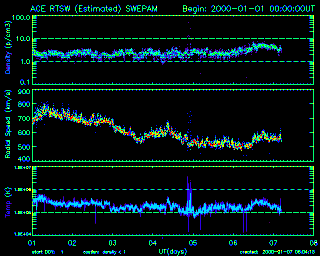
|
000107:
Yohkoh returns from hibernation
Yohkoh successfully started up again
after the New Year holiday, and we found no serious Y2K computer problems.
Mother Nature demonstrated that we still don't know much about the solar
origins of the mysteriously disappearing solar wind.
|
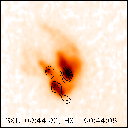
|
000114:
Exceptionally hard X-rays and an eruption
How can an X-ray be "hard" or "soft"? Some clues to this jargon, which
has its origins in medical X-ray terminology, help to understand why
solar scientists are fascinated by flares.
|
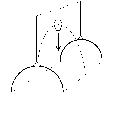
|
000121:
Motions above a spiky arcade
In this Nugget we follow up on an
earlier report
on motions in a spiky post-eruption structure that looks
like a punk musician's hair-do.
In this event SXT scientists have discovered
striking motions that have been predicted by theoretical models.
|
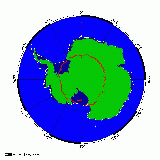
|
000128:
Homage to Flare Genesis
Some of the most exciting instrument development work in NASA's space
program takes place using balloons. In this Nugget we report on a
balloon that just completed a circumnavigation of the South Pole,
having observed the sun in continuous daylight for almost three weeks!
|

|
000204:
Time-lapse views and helioexalepidoptery
At the beginning of each 11-year sunspot cycle, most sunspots
emerge it least 20 degrees from the equator.
By the end, most spots emerge within 10 degrees of it.
A plot of the latitude of sunspots with time over one cycle looks like
the wings of butterfly, hence the title of this nugget.
|
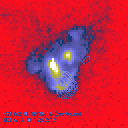
|
000211:
Already an X-flare in the new millennium
This X-flare, the subject of an alarmist BBC report,
was an interesting one (aren't they all?) in several respects --
it had a semi-detached precursor, itself a major event,
powerful ejections of plasma,
and hard X-ray sources that didn't match anyone's preconceptions.
|
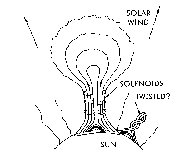
|
000218:
Theories, models, and cartoons
As used by astronomers, these words have rather uncommon meanings.
The meaning of the word "theory" is conventional -- a more or less established explanation accounting for known
facts or phenomena. However, models are not glamorous people, and cartoons are
not funny!
|
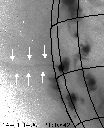
|
000225:
A wavy, twisty jet
We think jets occur when a reconnection event pumps hot plasma into long, thin
magnetic channels. This jet is unusual, though -- a
movie shows wave-like motion, or perhaps twisting
motion, which may reflect the relaxation of the magnetic field
after reconnection.
|
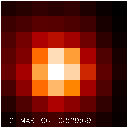
|
000303:
X-class flare induces (some) sympathetic effects
A "sympathetic flare" is one resulting from a perturbation caused by
another flare.
The flare that led to the sympathetic response is amazingly
small in area, considering that
its energy output puts it in the most powerful "X" class
(see the glossary).
|
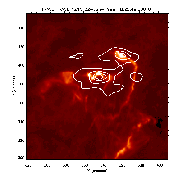
|
000310:
A knotty flare
The emission that comes from solar flares is created both by hot
plasmas (soft X-rays) and energetic electrons crashing into the dense
lower atmosphere (hard X-rays). Signatures from both processes are seen
in this flare.
|
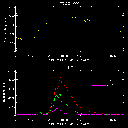
|
000317:
Controlled explosions
Many flares are eruptive -- associated with the launching of Coronal
Mass Ejections, for example. However, just to keep solar scientists on
their toes, Mother Nature gives us many flares in which no
evidence of eruption can be seen.
The fwo flares discussed here are good examples.
|
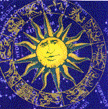
|
000324:
Amateur flare forecasting
Professional flare forecasters, like those at the
Space Environment Center of
the National Oceanic and Atmospheric Administration, use various
empirical methods. The goal of many solar physicists is to improve
such forecasting by making it more physics-based.
|
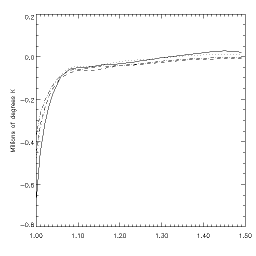
|
000331:
The inscrutable DEM
Many scientific results depend on careful quantitative analysis using
concepts like the Differential Emission Measure, or DEM, which is the
subject of this nugget. Solar physics is not just pretty pictures
(though we do throw one into this nugget, for good measure)!
|
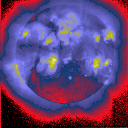
|
000407:
Solar variability
Here we look at the Sun as a star, through X-ray eyes.
Our guide is a scientist who shared in the discovery
that the energy output of the Sun was really not constant
-- thereby overturning hundreds of years of orthodoxy!
|
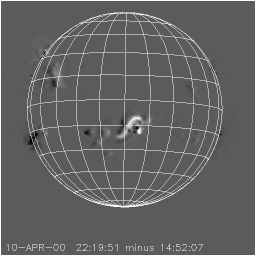
|
000414:
Sigmoid creationism
We usually think of the S-shaped structures which we call sigmoids
as precursors of Coronal Mass Ejections, after which they disappear and
are replaced by cusps or arcades. However, here is a case in
which a flare and CME caused a sigmoid to appear!
|
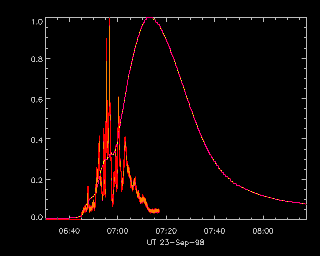
|
000421:
Ooops, missed a GEM!
Sometimes a wonderful phenomenon slips past our eagle-eyed view.
This science nugget reports a set of observations
of a major flare/CME event that took place over a year ago.
It was associated with
one of three really interesting recent geomagnetic disturbances.
|

|
000428:
Running in circles
Yohkoh has been in orbit for nigh on 9 years now.
Will atmospheric drag bring it down during this solar maximum?
Fortunately there's a rich and long-lived database of information to
tell us all about this, so let's have a look.
|
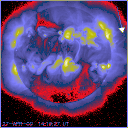
|
000505:
Another nice but accidental discovery
Maybe more often than not, scientific discoveries are accidental - not
really guided by profound and wise thought.
The discovery reported here began with an message from
the WIND/WAVES
experiment, a deep-space radio observatory that often detects solar
ejecta.
|

|
000512:
Fandango from an X-class flare - we think
This flare occurred on May 5,
a
major American holiday.
We think it was so big that, despite the fact that it occured on the
far side of the Sun, its effects wrapped around the Sun to the
visible hemisphere, where they were easily seen by Yohkoh and
other spacecraft.
|
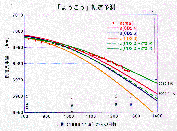
|
000519:
Long live Yohkoh!!
In a previous nugget
000428: Running in Circles we talked about how
the Earth's atmosphere drags on satellites and eventually causes them to
re-enter. We now have an expert opinion that shows Yohkoh may have
almost 10 more years to live!
|
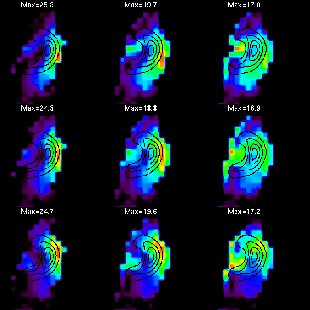
|
000526:
Temperatures of flares from Yohkoh data
Data analysis is a tricky business.
Often an interesting "discovery" turns out to be due to mis-use or
naive use of data.
It may not be a good idea to take SXT
filter-ratio temperature maps at face value, especially when you discuss
where in a flare intense heating takes place.
|

|
000602:
Recent observations of trans-equatorial interconnecting loops
This week, the Yohkoh data analysis room here at
ISAS
has been crowded with world experts on
trans-equatorial interconnecting loops (TILs).
The nature of TILs is not well understood, but they may
play an important role in global solar magnetism.
|
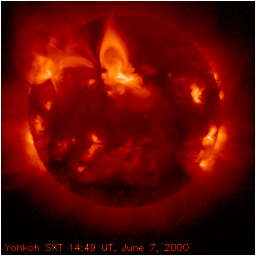
|
000609:
X-class flares illuminate a coronal problem
This week saw the occurrence of three X-class flares, all from a single
region.
However, a lovely cusp, formed during the events on June 6
wasn't perturbed by the flare and CME of June 7!
How in the world could a titanic CME explosion in the low corona not affect
the cusp structure directly above it?
|

|
000616:
Moving X-ray emission lines
Yohkoh has four instruments on board.
One of these is the Bragg Crystal Spectrometer (BCS) experiment, which
observes X-ray emission line spectra from four highly-ionized elements.
Although there are no pretty images from this experiment,
the spectroscopic information is quite valuable for the quantitative
study of the physics of solar flares.
|
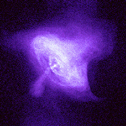
|
000623:
Yohkoh observes the Crab Nebula - it's sort of like a CME
The Crab Nebula, M1 in the Messier catalog of night-sky diffuse astronomical
objects, resulted from a supernova explosion within our galaxy in 1054 A.D.
On June 14 it came with 1.2 degrees of the Sun, so we swung the
Yohkoh satellite over to take a peek.
|
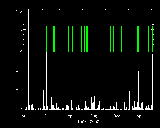
|
000630:
A flare catalog
In a tradition going back at least to Ptolemy, we've created a catalog
of certain solar flares -- those well observed by both the TRACE and
Yohkoh spacecraft.
We expect that this catalog will be used by other
solar physicists to identify flares that are well observed, and hence
suitable for special study.
|
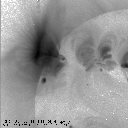
|
000707:
Spiny arcades
Arcades of loops are among the most beautiful structures seen by
Yohkoh, and some of them are graced with a spectacular fan of
spines. The spines seem to baffle theorists, who characteristically
just shrug when asked about them.
|
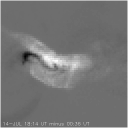
|
000714:
Super regions
After a long period of low flare activity, we finally got a super-region
-- one that produced three X-class flares, including what is the biggest
flare of the cycle, up to now. We're also pleased to note an obvious
pre-flare sigmoid, one of our favorite topics.
|
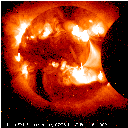
|
000721:
Cusps upon cusps
The cusp configuration in soft X-rays
has a unique implication to people studying the solar
corona -- magnetic reconnection.
The interesting thing this week was the occurrence of not
one, but two successive cusp features in the same active region.
|
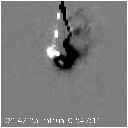
|
000728:
Seeing waves in the solar corona
The solar corona generates emission at all frequencies, including
radio waves.
The frequency of the emission is related to the density of the
ambient medium.
Bursts of radio emission of drifting frequency indicate
a large-scale shock wave moving out in the corona.
|
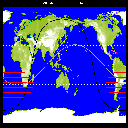
|
000804:
Making tracks
The very energetic particles known as cosmic rays were discovered using
the tracks they left behind in material through which they had passed.
We've found tracks in the images of Yohkoh, which we think are tracks
whose origins also lie in highly energetic particles.
|
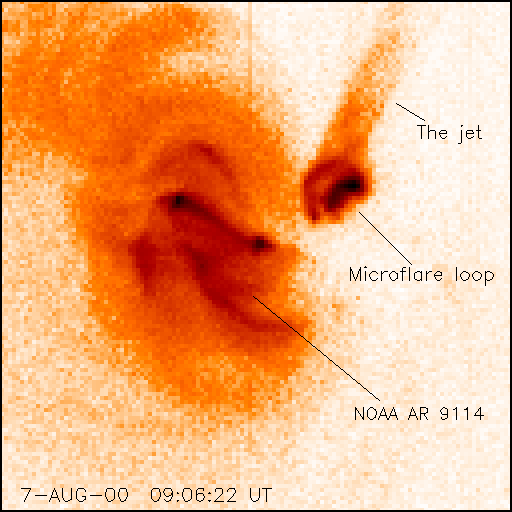
|
000811:
Catching an (X-Ray) jet
One of Yohkoh's nicer early discoveries was the X-ray jet phenomenon,
in which a column of hot plasma suddenly
shoots up into the corona. This week SXT got lucky and caught a jet
with its very best spatial resolution.
|
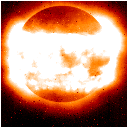
|
000818:
The deep south
This week we've had a sunspot group at an extreme southerly latitude.
How unusual is this? Is this southerly spot group setting any records?
Apparently sunspot groups have appeared at latitudes as extreme as 70
degrees, so really don't have a great discovery here.
|
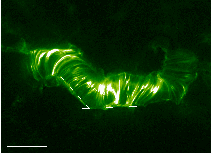
|
000825:
Cleaving like a guillotine
An arcade of coronal loops develops beautifully in this event.
The arcade is beautifully cylindrical in its
basic structure, but the chromosphere is fluffy and disorganized.
How can a higgledy-piggledy photospheric field accommodate to a serene and
regular coronal field?
|
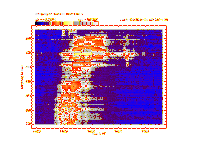
|
000901:
Lucky observations of a limb flare
In this nugget, we discuss oscillating loops resulting from a flare --
the objective of the miraculously successful observing program.
We managed to catch the ejection that stimulated these oscillations, of
which only a few other examples exist.
|

|
000908:
Pre-flare, flare, flare ejection
In this event SXT did a good job of getting images before,
during, and after the flare itself.
Some interesting parts may basically be invisible to SXT,
because the temperature there is not hot enough (several million
Kelvins) to emit the X-rays that SXT sees.
|

|
000915:
Hard X-ray ribbons
The Yohkoh Hard X-Ray Telescope recently produced a remarkable discovery
-- the first observation of flare ribbons in hard X-rays. Although such bright
ribbons have often been observed in visible light, this observation in
hard X-rays gives new evidence for particle acceleration in 3D.
|
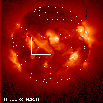
|
000922:
X pattern on the Sun
X-shaped patterns in Yohkoh images are important because they provide
observational evidence for how the dynamo works that generates solar
magnetism. Here is a spectacular example shown in movies from
both Yohkoh and SoHO.
|
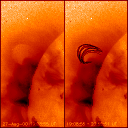
|
000929:
Shrinkage of coronal X-ray loops
One of the earliest big discoveries by the Yohkoh mission
was the discovery that the corona is continuously expanding.
In this nugget we say it ain't necessarily so ... sometimes, anyway.
|
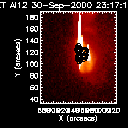
|
001006:
A confined flare with an interesting eruption
This week's nugget details the happenings of an X1.2 flare that
occurred on September 30 around 23:00 UT in NOAA Active Region #9177.
This event had an interesting eruption that starts in typical
fashion, but never gets anywhere -- i.e., it is "confined".
|

|
001013:
Lighting up a filament channel
Filament channels are the large-scale coronal features that
provide the support of a filament (if seen on the disk) or prominence (if seen
on the limb) against gravity. A filament is cold and dense and has no
right to be floating high up in the corona - thus magnetic levitation with a
hotly-debated geometry is required.
|

|
001020:
Coronal holes are stiff!
Coronal holes are large-scale features whose low plasma
density makes them look like a hole or a void.
They sometimes take the shape of meandering channels.
Strangely, they do not seem to know that the Sun does not rotate like
a solid body -- it takes almost a week longer to complete a rotation
at the poles than at the equator.
|

|
001027:
Whither pointest thou?
It will make you dizzy to watch the movies in this Nugget! Earlier this month
the Yohkoh spacecraft lost tracking of its guide star and the
telescope pointing became unstable --
the spacecraft rolled and wobbled for a while, until the operators got
it back under control.
|

|
001103:
Pointy-headed loops
Reading these Nuggets, one might get the idea that we're crazy about
"cusps", those pointy-shaped loops that are often seen in X-ray images
of
solar flares.
The reason we spend so much time looking at cusped loops is
simultaneously
simple and complicated: we like them because they tell us about the
topology of the magnetic field.
|

|
001110:
A beautifully observed X-ray jet
The linear squirts of X-ray plasma that we refer to as jets
are one of the most striking Yohkoh discoveries.
If you are going to look at just one jet movie, this is the one to
pick.
|
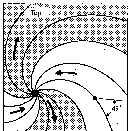
|
001117:
The importance of being well connected
In the tenuous corona, charged particles are forced to follow
magnetic field lines. The manner in which the magnetic field connects
the Sun to the Earth, and what happens on those areas on the Sun that
are well connected, has much to do with the effects of solar flares
on the Earth.
|
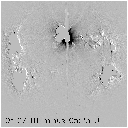
|
001124:
X-class flare: Murphy's law and revenge
This nugget was written just a few hours after Yohkoh almost
completely missed an X-class flare - a dreadful feeling.
No sooner was it finished than our luck changed dramatically.
Five M or X-class flares in a row
occurred during Yohkoh orbit day, outside the South Atlantic
Anomaly.
|
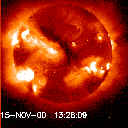
|
001201:
The CCD Nitty-Gritty Ditty
Yohkoh would not get all its beautiful images if it were not for
clever people who know how to build instruments that can survive in the
harsh environment of space. In this nugget one of those folk tells us
about the nitty-gritty of CCDs.
|

|
001208:
Birds of a feather - "homology"
Sometimes one sees two successive flares
which are called "homologous", i.e., they match closely in
appearance and temporal behavior.
This is a property (among many, of course) with which solar flare
theorists have not yet dealt successfully.
|
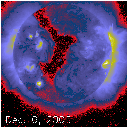
|
001215:
A gorgeous coronal hole
By a simple definition, a "coronal hole" is a dark domain in the corona.
Because of discoveries from the original Skylab solar X-ray images,
however, we're now convinced that these domains show where the solar wind
blows from, i.e., where the interplanetary
magnetic field is anchored.
|
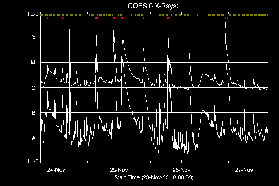
|
001222:
Big Flares Associated With Halo CMEs
At the end of a previous nugget, it was
reported that Yohkoh observed several intense flares during
24-26 November 2000.
These flares showed many of the phenomena associated with eruptions.
This week, we summarize what we saw during this special period, now
that all the data are in place.
|
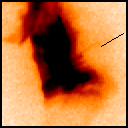
|
001229:
SAD news -- we're glad!
The 1999 discovery of streams of material flowing out of the corona and
apparently onto flare loops, called Supra-Arcade Downflows, or SADs,
is one of Yohkoh's bigger discoveries.
This discovery was made when we changed to a new observing mode,
but it turns out that perhaps we were seeing them all along in our
standard whole-Sun images.
|







































































































